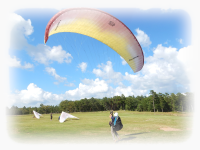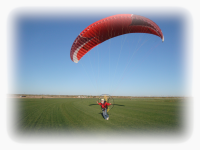Engine rubber mounts
by Had Robinson
Quick mount check: 1.) Engine off 2.) Put the propeller in the horizontal position. 3.) Grab the right tip (as you face forward) and pull hard back on the propeller. 4.) Look carefully at the right top engine mount as you hold the tip back. 5.) The mount should stretch nicely out. If it does anything else e.g. you see a crack right where the steel plates meet the rubber. REPLACE THE MOUNT IMMEDIATELY. 6.) Do the same for the other side. Note: The bottom mounts of either the engine or the exhaust system last much longer and rarely break. You should observe them, as well.
The (4) rubber mounts that hold the engine to the frame on all paramotors are normal, perishable items. That is, they have a limited life and will fail, usually around (50) hours depending on the size of the engine. Some mounts may only last about (10) hours. The mounts are attached with button-head screws on both ends. The button-head screws that are used on the (2) upper mounts should always have BLUE threadlock applied to them. If the paramotor is new, remove the screws and apply threadlock JUST IN CASE the factory forgot to do it.
It is a good idea to replace mounts in pairs i.e. the lower set or the upper set. This is because if one mount fails, the other is not far behind.
Why have the rubber mounts, anyway? Their purpose is to isolate the SEVERE vibration of the engine from the paramotor frame and, to a lesser extent, from the pilot. Two stroke aviation engines have so much vibration because they have small flywheels in order to keep the overall motor weight to a minimum. Greater weight – less vibration. Lesser weight – more vibration. Like everything in aviation, it is a trade-off. As all experienced, long time PPG pilots know, stress cracking of paramotor components is a serious problem and is why pilots must routinely and carefully check their paramotors for cracks.
I do not recommend the use of the "poly-type" mounts. This is because these mounts are stiffer and transmit more vibration to the paramotor frame. This is of negative value in the long run. In the short run there will be an appearance of less overall vibration but the stress on frame components will be greater. I have seen stress cracks on the frame tubing near joints, the aluminum fins used to divert more cooling air past the cylinder exhaust port, and on other parts of engines. Frame failure, in particular, could be a serious safety issue so it might be smart to minimize the transmission of vibration from the engine. Rubber mounts are the most flexible and will do the best job even though they are not as tough as some other mounts, like the poly-type mounts.
Here is an exhaust mount that is about to fail. The arrow points to a widening crack between the steel plate and the rubber. This is what pilots should look for when inspecting the mounts on their engines. It is hard to see sometimes and why the mounts must be stressed.
If pilots still want to replace these mounts with the heavy duty Viking PPG Poly Motor Mounts, they must be CERTAIN that the new mounts do not touch any parts on the motor or frame.
The Polini Thor 130 below suffered a catastrophic failure of the starter where it separated from the motor while the pilot was in the air.
What had happened was the pilot had installed the Viking mounts but did not check the clearance from one of the mounts to one of the starter mounting tabs. The severe vibration of the motor caused the starter tab to start wearing down the mount. But after a while, the forces were so great that they caused the starter screws to shear where they entered the screw holes on the engine. Two screws sheared off and the third had its threads stripped.
The front of the Thor 130 with the starter removed showing the lower Viking Poly PPG motor mount that had rubbed against one of the starter mounting tabs (lower right). The Polini starter is poorly engineered in the first place so it did not take much for it to fail. This is a serious bug but worth putting up with, in my opinion, because of other outstanding features of the Polini, such as it being so quiet and, otherwise, reliable. But I wish they would fix the starter problem. As of 2019, Polini has made some improvements in the starter that make it somewhat more durable.
On the Polini engines with the Viking mounts, pilots must grind down the lower left mount so that it does not touch the starter mounting tabs. A 1/4 inch clearance should be sufficient.
Modifications to engines, in general, must be thoroughly reviewed and checked for potential problems like this one. One thing is common to all paramotors: They all vibrate severely, especially the larger engines. As a result, motor mounts should be checked routinely and replaced promptly. Pilots can use heavy duty nylon zip ties to prevent the engine from moving away from the frame if a mount breaks. Some engines have a nylon webbing strap for the this purpose.
![]()




